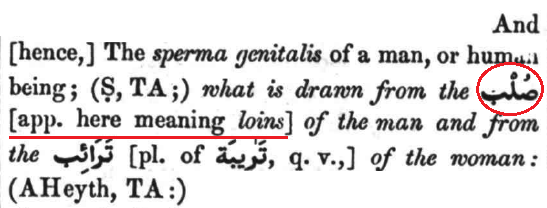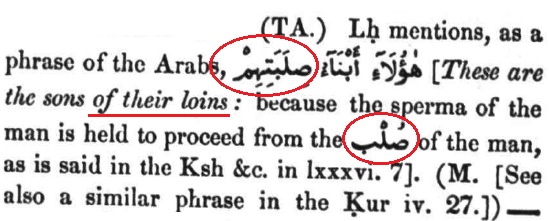
The articles on this website
may be reproduced freely as long as the following source reference is provided:
Joseph A Islam
www.quransmessage.com

Salamun Alaikum (Peace be upon you)
VERSE 86:7 - HUMAN CREATION

 Printer
Friendly Version
Printer
Friendly Version
Copyright © 2009 Joseph A Islam: Article last modified 23rd February
2014
BACKGROUND
The
verses below (in particular verse 86:7) have often been the source of
much debate and controversy between Muslims and those critical towards the
Quran's authenticity.
086.005
"So let man consider from what he is created"
086.006
"He is created from a gushing fluid /
water pouring forth (main dafiqan)"
086:007
"Coming forth from between the
'al-sulb'
and the 'al-taraib'"
English translations provide various
meanings to the Arabic words 'al-sulb' (plural: aslab) and 'al-tara'ib'
(plural of taribah) such as backbone and the
ribs respectively of a
male. If
interpreted in this manner, this would arguably present challenges with modern
understandings of human biology. However, challenges aside which is not the
focus of this article, there does appear
to be a lean on many modern interpretations which seem to suggest a skewed
focus of this verse towards semen production within the male anatomy, as if
to somehow suggest scientific marvels to its
readers. Such interpretations have inevitably attracted strong criticism
from various theological perspectives.
Whatever may be the most scholarly approach to
ascertain the best meaning of the Quranic words in question, it should be recognised that the Quran was speaking primarily
to an Arab audience of the 7th century to offer them spiritual guidance
foremost and not arguably to equip them with a new understanding of the
human anatomy, that was otherwise unknown to them.
The Quran’s
intention was certainly not to present a dialogue to 21st century
scientists conversant with modern technological advancements or to present
itself as a science reference manual with a view to provide new information
with regards human biology or semen production within the male anatomy.
The point of the verses was simply to provide a
spiritual lesson to its immediate audience that if God could create a human being
from
such humble, meagre beginnings, God could also, without any doubt, resurrect
humans from their death. The latter sentiment is given by the very next
verse in no uncertain terms.
086.008
"Indeed,
He
is able to bring him back (to life)!"
It is also noteworthy that the Quran addresses themes
of procreation in the most eloquent manner and not by distasteful graphical
depictions. For example, refraining from illicit sexual liaisons is
described eloquently as guarding ones modesty / private parts (23:5)
or intimacy is presented as an analogy with a farmer tilling the soil with a
view to cultivate (2:223) or as being referred to as being covered (taghashaha
- 7:189).
It is inconceivable that the Arabs would not have known
how humans were formed. Therefore, the relevance of the verse must therefore
be understood under the spotlight of the spiritual lesson that it intends to
impart and not a complex lesson in human reproduction.
ANALYSIS
The most fundamental point to note is that the verses
in question do not speak exclusively of semen production alone. The focus is regarding
'human' formation.
"So let man consider from what
he is created"
(86:5)
A human being is not formed from semen alone but by the
combination of genetic material from both sexes, male and female.
Two crucial words will be analysed with the following
approach:
(1) From a Quran's perspective
and usage.
(2) From classical Arabic
lexicons and language sources.
1
- AL SULB (Noun)
The Arabic word
'Sulb' is well attested in classical Arabic lexicons to mean ‘loins’.
"(loins)
chiefly • literary the
region of the sexual organs regarded as the source of erotic or
procreative power"
[1]
This
understanding is primarily supported by a Quranic verse where the meaning to the word 'Sulb'
is evident as referring to the male loins via which life forming
secretion is emitted to form human life.

Illustration - Joseph Islam
004:023 (part)
"...and the wives / spouses of your sons those who are from
your loins (aSLABikum)"
This rendition of the term 'sulb' to
infer 'loins' is further supported by classical Arabic
lexicons:

Source: Edward Lanes Lexicon
[2]

Source: Edward Lanes Lexicon
[3]
Therefore the Quran describes life forming fluid as gushing forth
(main dafiqin) (86:6) from the male
loins.
2
- AL TARA'IB (Noun Plural)
The Arabic word
'al-tara'ib' is a hapax legomenon and is used in this form
only once in the entire Quran. Hence any cogent interpretation of the
term should arguably be conducted through the language sources of the Arabs
which would make best sense with the Quran's overarching context.
As mentioned in
the opening paragraphs, it is inconceivable that the Arabs of the Prophetic
ministry would not have known what the term meant or what the human
procreation process generally entailed.
'Al-Tara'ib' is well understood to be an archaic
word and uncommon. Its rarity is also evidenced by the various
interpretations advanced by classical authorities in the works of
lexicographers. However, one point that remains evident from classical lexicons
is that
‘Al-Tara'ib’ is a reference specifically to a female counterpart and not
generally part of the male anatomy.

Source: Edward Lanes Lexicon
[4]
The
core meaning of the ‘Al-Taraib’ seems to encompass the bones of the breast,
as is evidenced from the various meanings that linguistic authorities have
imparted in classic lexicons.
تريبة , (S, M, TA,) or ↓ تَرِيبٌ , (TA,) sing. of
تَرَائِبُ , (S, M, TA,) which signifies The part of the breast which is
the place of the collar, or necklace: (T, M, K:) so by the common
consent of the lexicologists: (T:) or the bones of the breast: (M, A,
K:) or the bones of the breast that are between the collar-bone and the
pap: (S:) or the part of the breast, or chest, that is next to the two
collar-bones: or the part that is between the two breasts and the
collar-bones: or four ribs of the right side of the chest and four of
the left thereof: (M, K:) or the two arms and two legs and two eyes: (T,
M, K:) it is also said that the تَرِيبَتَانِ are the two ribs that are
next to the two collar-bones: IAth says that the تَرِيبَة is the
uppermost part of the human breast, beneath the chin; and its pl. is as
above: accord. to IF, in the Mj, the ↓ تريب is the breast, or chest: MF
says that ترائب relates to males and females in common; but most of the
authors on strange words affirm decidedly that it is peculiar to women:
(TA:)
Source: Edward Lanes Lexicon
[5]
Such a diverse
meaning involving the different bones of the rib cage and breast is also
picked up by other dictionaries of note.

[6] WEHR.
H, A Dictionary of Modern Written Arabic

[7]
PENRICE, J, A Dictionary and Glossary of the Koran 1873

[8] AL
MAWRID - A
Modern Arabic-English Dictionary.

[9] WORTABETS
Arabic English Dictionary.

[10] OMAR,
A M, Dictionary of the Holy Quran, Arabic Words
However,
classical lexicons also clearly state that ‘Tara'ib’ can be a
reference to the ‘two arms,
and two legs and two eyes’.

Source: Edward Lanes Lexicon
[11]
This would suggest a representation of the female anatomy
in more holistic, encompassing terms. This would not
be unusual as the Quran is seen to capture human activity by referring to
general parts of the anatomy.
060:012 (part)
“...nor bring or produce any lie / slander that they have devised / invented
between their hands and feet...”
Therefore, it can be safely
posited from classical sources that 'al-Taraib' whilst being a rare
word, is a plural noun
depicting the female anatomy in general, and in verse 86:7, it can encompass the
female reproductive anatomy holistically.
Thus the verses present an
evident reality of human life as being formed from humble beginnings via a
life forming fluid which issues forth from the male anatomy (sulb)
and involving the female anatomy (tara'ib).
This conclusion is also
supported by presenting the following analogy with another verse of the
Quran.
ANALOGY WITH VERSE 16:66
016.066
"And indeed, in the cattle is a lesson. From what is
in their bellies from between
(min bayni) the
bowel contents (farth) and
blood (dam), We produce for you drink,
milk, pure and palatable to those who drink it."
This is comparable with the verses in this article in the following manner
given the highlighted emphasis below:
086.005-7
"So let man consider from what he is created.
He is created from a gushing fluid / water
pouring forth, coming forth from between
(min bayni)
the 'al-sulb' (male loins) and the
'al-taraib' (female anatomy)."
Therefore,
Verse 16:66
Laban (milk)
is CREATED from what is in their bellies
FROM WHAT IS BETWEEN (min bayni)
[BOWEL CONTENTS] AND BLOOD
Therefore, milk is produced as
a by-product of two entities 1 (bowel contents) + 2 (blood).
Similarly,
Verse 86:5-7
Human life is
CREATED of a life fluid / water pouring forth (86:5)
FROM WHAT IS BETWEEN (min bayni)
Al-SULB (male) AND 'AL-TARA'IB' (female)
Therefore, humans are produced
as a by-product of two entities 1 (male anatomy) + 2 (female anatomy).

FINAL THOUGHTS
The Quran highlights a spiritual reality. If humans can be created from such
meagre beginnings, there is absolutely no doubt that God can recreate life.
After all, as the Quran asserts, what is harder to create? - The first creation or
the subsequent creation?
050:015
"Were We then worn out / tired by the first creation?
Nay!, yet they are in doubt about a new creation!"
The depiction of human form from humble beginnings is depicted in a manner which
remains encompassing and speaks to an audience who would have been familiar with
human reproduction. In verses 86:5-7, this reality is merely depicted as a life
forming fluid which issues forth from the male counterpart (sulb)
and involves the female counterpart (tara'ib) which in turn produces human
life.
The exact meaning
of the word 'al-Taraib' would have been well known to the immediate audience of
the prophetic ministry as the Quran was revealed in their vernacular, though arguably becoming archaic
in use, afterwards.
However, the meaning of 'tara'ib' as a reference to the female anatomy is well
attested by classical Arabic lexicons as has been evidenced above. This would
also present human creation in its most basic form for its primary audience and
in a manner that they would be familiar with, whilst retaining focus on the
spiritual message that the Quran intends to impart.
Related Article:
(1)
Scientific Miracles in the Quran
REFERENCES
[1] Oxford
Dictionaries [online]
http://www.oxforddictionaries.com/definition/english/loin?q=loin
[Accessed]
20th February 2014
[2] LANE. E.W,
Edward Lanes Lexicon, Williams and Norgate 1863; Librairie du Liban
Beirut-Lebanon 1968, Volume 4, Page 1397
Highlights marked in red on
the lexicon excerpt are my own insertions. They have no bearing on the original
text other than they emphasise relevance to the topic at hand. These are merely
illustrations and have solely been utilised for educational and explanatory
purposes.
[3] Ibid.,
Volume 4, 1712
[4] Ibid.,
Volume 1, 301
[5] Ibid.
[6] WEHR.
H, A Dictionary of Modern Written Arabic, Edited by J.Milton Cowan, 3rd Edition,
Spoken Languages Services Inc. 1976, Page 92
[7] PENRICE, J, A
Dictionary and Glossary of the Koran 1873; Reprint 1991 Adam Publishers &
Distributors, Delhi, Page 22
[8] AL
MAWRID - A Modern
Arabic-English Dictionary. Dr. Rohi Baalbaki, Dar El-Ilm Lilmalayin, Seventh
Edition 1995, Page 312
[9] WORTABETS
Arabic English Dictionary, Page 48
[10] OMAR,
A M, Dictionary of the Holy Quran, Arabic Words - English Meanings, Noor
Foundation - International Inc, First Edition May 24, 2003, Reprint used
February 26 2010, Page 74


![]()







